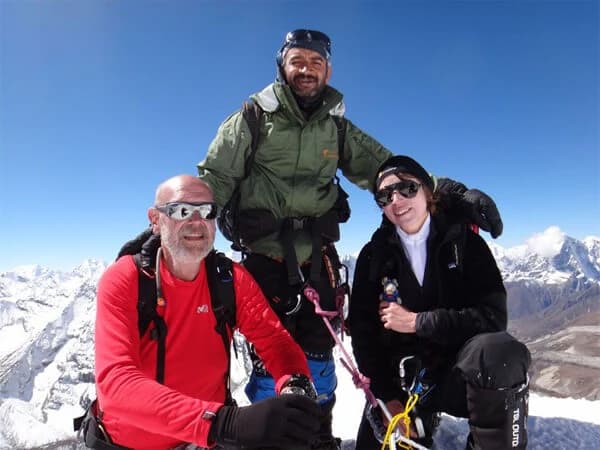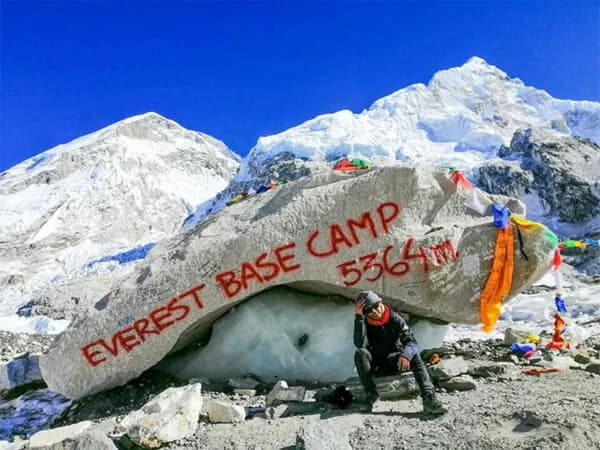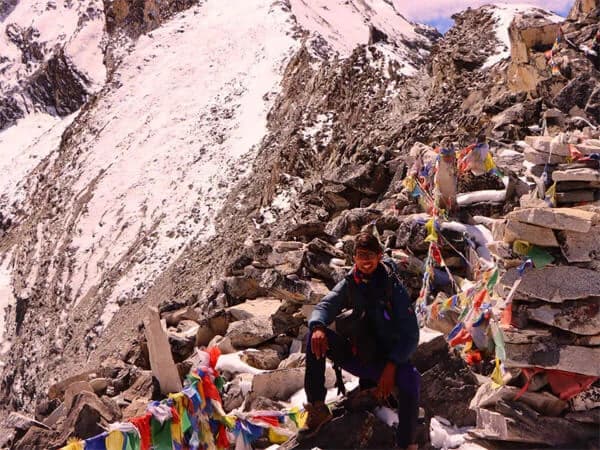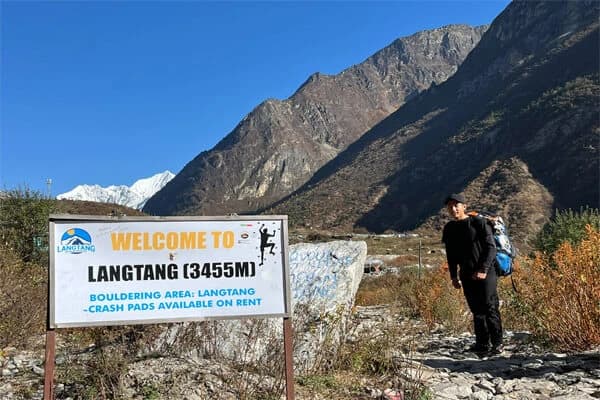I had been dreaming of the Everest Base Camp hike for years. Like a lot of others, I had read about climbers reaching the summit and seen images of Mount Everest. I only wanted to be at the foot of the largest mountain in the world and experience its power up close; I had no intention of climbing Everest.
I felt emotionally, mentally, and physically prepared, therefore I decided to hike in 2025. After years of leading a busy life, I needed a vacation that would challenge my body, let me decompress, and re-establish a connection with nature. I was drawn to the Himalayas by their strength, beauty, and quiet.
The growing interest of trekking and outdoor tourism following the pandemic was another factor. 2025 seemed like the ideal year to visit the mountains for the first time. By selecting a reputable trekking organization like Nepal Trekking Routes, I also hoped to help out local guides and porters.
There was more to this journey than trekking. Finding serenity, pushing myself, and doing something I would never forget were the goals. And I got all of that and more at Everest Base Camp.
Preparing for the Trek to Everest Base Camp
It required time, preparation, and a little bravery to get ready for the climbing to Everest Base Camp. I knew this would be one of the most difficult tasks I had ever faced, so I was both anxious and delighted. Every step leading up to the climb was important, from conditioning my body to selecting the best trekking company.
I thoroughly researched the trek's conditions before I even began packing. I learned that, depending on the route and the number of rest days, the Everest Base Camp trip takes roughly 12 to 14 days. I discovered that I needed to exercise caution when it came to altitude because the track reaches up to 5,364 meters.
A few months prior to the trip, I began walking large distances to prepare my physique. I read that the trail included a lot of climbing, so I added hills and stairs to my program. In order to help me later on when I was walking uphill at high altitudes, I also concentrated on strengthening my breathing and endurance.
Packing for Everest Base Camp Trail
 More than just a trek, the Everest Base Camp trail takes hikers through picturesque villages, hanging bridges, pine forests, and expansive alpine valleys. I packed carefully because I wanted to enjoy every moment of it.
More than just a trek, the Everest Base Camp trail takes hikers through picturesque villages, hanging bridges, pine forests, and expansive alpine valleys. I packed carefully because I wanted to enjoy every moment of it.
I made sure to pack a sleeping bag for chilly evenings, sturdy hiking boots, layers of warm clothing, and a waterproof jacket. Because the sun may still be very powerful in chilly weather, I also brought snacks, lip balm, sunscreen, and water-purifying tablets.
Everest trekking permits 2025/026
Selecting a reputable trekking organization was also crucial. I chose to travel to EBC with Nepal Trekking Routes, a local company that specializes in guided hikes. They assisted me in obtaining my Sagarmatha National Park Permit and Trekking Information Management System (TIMS) card, both of which are required for the trek. The itinerary, safety precautions, and what to do if I felt ill were all covered by their guide.
Purchasing travel insurance was yet another essential component of my planning. My insurance covered helicopter evacuation up to 6,000 meters because I was going to a high place where accidents or altitude sickness could occur. Knowing that I would be taken care of in an emergency provided me comfort.
Acclimatization on Everest trek
I also researched the prevention of Acute Mountain Sickness (AMS). The strategy included taking plenty of fluids, moving gently, and getting enough sleep. I was able to adapt to the thin air much more easily since my guide made sure we had additional break days for acclimatization.
I was able to take use of modern services and improved trekking facilities because I scheduled my walk for 2025. The majority of the teahouses had Wi-Fi (at an additional fee), warm beds, and nice meals, and the trails were in good shape. Nepal is genuinely prepared to accept more hikers.
Packing my bags wasn't the only thing I had to do to be ready for this trip, I also had to get my body and mind ready for an amazing experience. I was confident and thrilled when I eventually stepped onto the Everest Base Camp trek because I had taken the time to prepare.
Starting the Everest Hiking Adventure
My Everest Base Camp journey started in Kathmandu, the bustling capital of Nepal, following months of preparation and dreaming. The streets were vibrant, noisy, and lively; they were very different from the serene mountains I was approaching. But despite the hustle and bustle, I felt at ease knowing that one of the greatest adventures of my life was about to begin.
The flight to Lukla, a tiny mountain hamlet where the real trek starts, was the next significant step. This flight is brief, exciting, and occasionally a touch frightening, according to the many stories I've heard about it. Only around 15 people were on board the little aircraft, and Lukla's landing strip is extremely narrow and encircled by steep slopes.
However, the window's views were breathtaking, including deep valleys, verdant hills, and the first hint of snow-capped peaks.
I was ecstatic when we made a safe landing at Lukla. I was finally able to exclaim, "I'm here," when the crisp mountain air touched my face. The journey has begun. From Lukla, the route wound through serene pine trees, swinging suspension bridges, and tiny towns. Yaks, prayer flags, and happy villagers filled the trail. The Himalayas seemed to be getting closer with each step.
We spent the first night in Phakding at a little teahouse. A bed, a cozy blanket, and some delectable dal bhat (rice and lentils) were all that was needed. But I was so grateful and full of wonder that I fell asleep like a newborn.
Everest Base Camp Trek Cost
One of my main concerns while considering a climb to Everest Base Camp was the expense. I thought it would be worth every rupee, even though I knew it wouldn't be inexpensive. I had been dreaming about this trip for years, so it was more than just a vacation. I therefore made the decision to maximize it, budget carefully, and plan ahead.
I didn't go on an extravagant trek, but I also didn't go over budget. I went with Nepal Trekking Routes, a local trekking agency that provided me with excellent service, a helpful guide, and all the assistance I required. This balance, in my opinion, made the trip easier and more pleasurable.
Having a porter made climbing easier, and the guide assisted with everything from reserving tea houses to obtaining permits.
The tour, lunch, and flights accounted for the majority of the expenses. As we ascended higher on the trail, costs increased, particularly for snacks and meals. However, I recognized that transporting anything to these isolated settlements requires work. I made every effort to help out local companies. The full Everest Base Camp trek can cost anywhere from $1,200 to $2,000 USD, depending on how you travel—budget or more comfortable.
Yes, the climb to Everest Base Camp ultimately cost me a significant sum of money. However, I didn't give the money a second thought when I was standing at the foot of Mount Everest, with happiness in my heart and snow beneath my feet. All I could think about was how far I'd come in life and on the trail.
I gained more from my walk than I hoped for, including pride, serenity, and a moment I will always cherish. The price was irrelevant for that. It was an absolutely invaluable experience.
EBC Trek Itinerary 2025/026
Hiking to Everest Base Camp is about every moment spent on the journey, not simply the final goal. Regardless of the route you choose, every step offers fresh scenery, a more profound breath, and a closer bond with the mountains. Based on the three most popular trek alternatives, allow me to describe my experience.
EBC Trek 10 Days Itinerary
The 10-day trek is a difficult but manageable choice if you're short on time but yet wish to reach Everest Base Camp. Those who are already fit, used to hiking at high elevations, or have prior experience trekking in the Himalayas are the best fit for the trek.
The pace of the trail is faster. Your body must quickly acclimate because there are fewer days of rest or acclimatization. This implies a faster climb to higher altitudes and more walking hours each day. You won't stop at any of the same famous locations, such as Dingboche, Tengboche Monastery, and Namche Bazaar.
The 10-day schedule has significant dangers even though it takes you to Base Camp and back quickly. The change in altitude may seem abrupt. You'll need to eat healthily, drink a lot of water, and pay close attention to your body. This pace might have been a little too quick for me to really appreciate the scenery, but it's ideal for experienced hikers with little time.
The scenery is equally stunning. You continue to go through towering suspension bridges, travel under Ama Dablam's shadow, and eventually arrive at the Khumbu Icefall's edge. Even if you only have a little window to enjoy it, it's Everest—raw, real, and unforgettable.
EBC Trek 13 days Itinerary
For good reason, a lot of trekkers opt for this path. Adventure and caution are balanced. The 13-day trek allows your body the time it needs to acclimate to the altitude, with an additional two days or so added in for acclimatization. It also allows your mind and heart to process everything.
This speed allowed me to be much more present, which I enjoyed. I had time to stroll through the neighborhood market, enjoy a cup of tea in a cozy teahouse, and go to the Everest View Hotel in Namche Bazaar to catch my first far-off look at the majestic peak. It was soul-filling, steady, and gradual. I could indeed feel the air thinning later in Dingboche and Lobuche, but I didn't feel hurried. In order to strengthen my body and prevent altitude sickness, the rest days included quick excursions to higher overlooks.
Little pleasures like seeing Himalayan birds, listening to the solitude of the mountains, speaking with other trekkers from around the world, and watching prayer flags dance in the wind were all made possible by the 13-day path.
EBC Trek 14 days Itinerary
The 14-day itinerary is the ideal choice if you want to truly slow down and enjoy every moment of the journey. For first-time hikers or anyone who want to stroll at a leisurely pace and cherish each moment, this is the most recommended itinerary.
Particularly in the early days, this route has shorter hiking sections and two rest days. This implies that you arrive at Everest Base Camp in better physical and emotional condition.
The ability to develop relationships with the trail, the locals, and the mountains was what I cherished most about this pace. I could ask my guide about his early years in the Khumbu as we were having lunch together. I could visit monasteries, spin prayer wheels, and have evening tea with the people living there.
I also didn't feel hurried on the trip back. I had time to consider what I had witnessed and my progress. It felt less like a race and more like a pilgrimage.
That brief period of time made a significant emotional impact, despite the fact that it requires one more day than the 13-day walk. It gave the trip breathing room.
Whether you decide on a 10-day, 13-day, or 14-days Everest Base Camp trek, you will be surrounded by giants in spirit and in environment. However, depending on the pace, your experience will feel completely different. I was able to see, feel, and connect more when I slowed down. The 10-day journey is a daring and effective option if you're young, physically healthy, and comfortable at high elevations. The 13-day version provides structure and safety if you're looking for balance. The 14-day route is also your best option if you want to take your time and listen to the mountains.
Regardless of the route you pick, getting to Everest Base Camp involves more than just taking steps; it also involves how you take them.
Challenges Along the Way

Trekking to Everest Base Camp difficulty, despite the breathtaking views. It put my patience, body, and mind to the test. However, every obstacle also added significance to the trip. Two of the most important things I learned to manage were the weather and the trail's difficulty.
Everest Base Camp Weather in 2025
One of the main elements influencing your walk is the weather. I'm pleased I took the seasons into consideration when I made my 2025 Everest Base Camp hiking plans.
Trekking is most enjoyable in the spring (March to May). The temperature is not too frigid, the rhododendrons are in bloom, and the skies are typically clear. I went with late April, and most days had nice weather. Although the mornings were sunny, clouds frequently moved in by the afternoon, and at higher elevations it occasionally rained or snowed gently.
Another well-liked time of year is Autumn (September to November). There is good visibility and dry weather. This is a terrific time to visit if you want to see the mountains in their best light. Just be ready for cold evenings.
I stayed away from the Monsoon (June to August) season because of the excessive rain and slick roads. Even though the skies can be clear, Winter (December to February) is very cold, and many lodges close at higher elevations.
The weather in the mountains can change rapidly, even during the greatest trekking seasons. It can be sunny one moment and then foggy or snowy the next. I discovered how to be adaptable with my daily schedule, layer my clothes, and have my rain gear close at hand.
Even if the weather remained mostly constant in 2025, I still had to deal with wind, snow, and chilly evenings. The temperature fell below freezing at higher elevations, such as Lobuche and Gorak Shep. I almost lost my equilibrium one day due to a strong wind. Therefore, having appropriate equipment is crucial, particularly warm jackets, gloves, and sturdy boots.
How Hard Is Everest Base Camp Trek?
Most of my friends said, "Isn't that really hard?" when I informed them I was planning to trek to Everest Base Camp. Now for my honest response: It's difficult, but not impossible.
Although you don't have to be an athlete to finish the trek, you will need to have patience, mental toughness, and a fair degree of fitness. You walk for five to eight hours every day over the lengthy trek, which often lasts 12 to 14 days. Every step feels heavier at high altitude, as the paths are frequently up and down.
The largest challenge is altitude. There is less oxygen in the air as you ascend. About 3,500 meters is when I first started to feel out of breath. Fatigue and headaches became common. Acclimatization days are crucial for this reason. My body adapted to the height better while I rested in locations like Namche Bazaar and Dingboche.
Additionally, the hike causes strain on the feet and knees. I greatly benefited from having a decent backpack, appropriate footwear, and walking poles. In order to keep strong, I also learnt to walk slowly and drink a lot of water. Even while it was physically demanding, the mental aspect was equally important. On some days, I was so exhausted that I longed to go back. However, I kept going ahead by the beauty of the mountains, the generosity of the locals, and the support of fellow hikers.
Reaching Everest Base Camp
The last part of the Lukla to Everest Base Camp journey was both thrilling and moving after many days of traversing serene mountain villages and breathtaking scenery. We set out early in the morning from Lobuche and traveled gradually to Gorakshep, the final destination before Base Camp. The snowy peaks surrounding us gave us the strength to continue even if the air was thinner and every step felt more difficult.
We deposited our luggage at Gorakshep, ate a quick lunch, and then started the last trek to Everest Base Camp. Even though the terrain was dusty and rocky, we were now quite close. Each step was filled with excitement.
Mount Everest Base Camp Experience
Standing at 5,364 meters, in front of the Everest Base Camp sign, was one of the most powerful moments of my life. I was surrounded by giant peaks, colorful prayer flags, and the sound of wind rushing through the valley. We couldn’t see the summit of Mount Everest from Base Camp, but the view of the Khumbu Icefall was stunning.
Some people cried. Others cheered. I stood quietly, letting it all sink in. I had dreamed of this day for years, and now it was real.
Everest Region Teahouse Trek

Staying in teahouses along the route was one of the highlights of this trip. The opportunity to interact with the local Sherpa people is what makes the Everest region teahouse trek unique. We were greeted with warm tea, hot meals, and kind smiles every evening. Despite their simplicity, the accommodations felt familiar after a strenuous day of climbing.
The scent of hot soup, the crackle of a fire in the dining room, and the quiet of the mountains at night are all things I will never forget. These little things added to the trek's significance.
Feelings at the Top of the World
The journey to Everest Base Camp was as much about the experience as it was about the scenery. The last moment was made much more memorable by the long walking days, the chilly nights, the aching legs, and even the moments when I wasn't sure.
This journey served as a reminder that the greatest things in life frequently call for bravery, perseverance, and patience. I didn't trek for a living. I was just a person with a strong heart and a dream.
A Memory That Stays Forever
I knew this experience would last a lifetime as we made our way back to Gorakshep that evening, exhausted yet joyful. It was the Lukla to Everest Base Camp hike that transformed me. I gained confidence, calmness, and a deep love for the mountains as a result.
Go for it if you're considering going on this trip. Enjoy each moment, take your time, and breathe in the clean mountain air. Every step is worthwhile as Everest Base Camp awaits.
The Return Journey of Nepal Himalaya Trekking 2025/026
Heading Back from the Base Camp
It was time to turn around and start the journey back after a few memorable experiences at Everest Base Camp. I was pleased, proud, and a bit tearful. The descent hike was difficult on the knees but easier on the lungs. I was able to take in views that I had missed on the trip up, and the weather remained clear. It was almost like coming home now, every village I passed felt more familiar.
Noticing the details I missed
I was frequently preoccupied with breathing, remaining warm, and getting to the next station on the way up. However, on the way back, I had more energy to explore and observe the scenery, the mountains, the woods, and the little things. I chatted with other hikers for longer, took more pictures, and smiled more. I even stayed longer in Namche Bazaar, where I talked to the local store owners and sipped on fresh coffee.
Reflections on the Journey
I gained much more from my hike than just sights of the mountains. It gave me strength, patience, and the ability to remain composed in the face of difficulty. I recalled waking up at Gorakshep in the morning, exhausted and cold, but eager to go to base camp. I will always remember that feeling of persevering and eventually standing there.
Suggestions for Upcoming Trekkers
I strongly suggest trekking to Everest Base Camp if you're considering it. However, you must be ready for the altitude, the long walks, and changing weather. My most important piece of advice? Pick the ideal moment to leave.
Best Time to Hike Everest Base Camp
"When is the best time to hike Everest Base Camp?" is a question that many people have. In all honesty, I believe that October was the ideal month for my expedition. The weather was dry, the skies were clear, and the scenery was breathtaking. Here is a brief summary of the seasons.
One of the greatest seasons to walk to Everest Base Camp is from March to May (spring). Beautiful rhododendrons will be in flower when the weather warms. Autumn, from September to November, is also regarded as the ideal season. I decided on October because of the fantastic clarity, which was ideal for taking pictures and seeing the mountains.
Winter, December to February. is chilly but peaceful. The trail may be snowy, and several lodges may be closed. The monsoon season, which runs from June to August, is not advised because of the high levels of rain and clouds, however some people still like the serene, green paths. Depending on your tolerance for crowds and preferred weather, spring or fall are the ideal seasons to hiking to Everest Base Camp.
Returning Home Feeling Complete
Flying back to Kathmandu after the trek was like entering a new planet. No more chilly evenings or early-morning ascents—but I nearly missed the trail right away. I was transformed by this journey. It served as a reminder that nature has a unique ability to inspire and heal us, and that I am stronger than I realize.
Don't wait if you've ever wanted to stand at the foot of Mount Everest. Make a good plan, travel at the ideal time, and let the mountains take care of the rest.
Conclusion: Everest base camp Hiking
More than just stunning scenery and pictures, Hiking to Everest Base Camp offered me a deep feeling of calm, strength, and confidence. High altitudes, chilly nights, and difficult paths were all part of the experience, but I also learned how resilient and patient I could be. I was able to slow down and savor every minute thanks to the serene mountains. I felt like I belonged to something greater and met nice people, both locals and other hikers.
This trek was a journey within me as much as it was a journey through Nepal. I discovered that even in difficult situations, I should trust my steps. I genuinely think it's an experience that will last a lifetime if you're considering doing it.


 More than just a trek, the Everest Base Camp trail takes hikers through picturesque villages, hanging bridges, pine forests, and expansive alpine valleys. I packed carefully because I wanted to enjoy every moment of it.
More than just a trek, the Everest Base Camp trail takes hikers through picturesque villages, hanging bridges, pine forests, and expansive alpine valleys. I packed carefully because I wanted to enjoy every moment of it.








